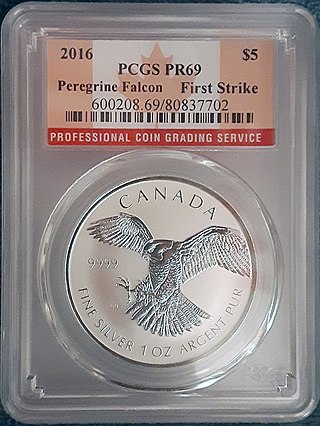
Coin grading is the process of determining the grade or condition of a coin, one of the key factors in determining its collectible value. A coin's grade is generally determined by six criteria: strike, preservation, luster, color, attractiveness, and occasionally the country/state in which it was minted. Several grading systems have been developed. Certification services professionally grade coins for tiered fees.

The quarter, short for quarter dollar, is a Canadian coin worth 25 cents or one-fourth of a Canadian dollar. It is a small, circular coin of silver colour. According to the Royal Canadian Mint, the official name for the coin is the 25-cent piece, but in practice it is usually called a "quarter", much like its American counterpart. In Canadian French, it is called a caribou or trente sous. The coin is produced at the Royal Canadian Mint's facility in Winnipeg, Manitoba.

The American Silver Eagle is the official silver bullion coin of the United States.

Numismatic Guaranty Company (NGC) is an international third-party coin grading and certification service based in Sarasota, Florida. It has certified more than 60 million coins. NGC certification consists of authentication, grading, attribution, and encapsulation in clear plastic holders. NGC is a subsidiary of Certified Collectibles Group (CCG), which owns six collectible certification services and is in turn owned by Blackstone, a multibillion-dollar New York City hedge fund.

A key date is a term used in coin collecting and it refers to a date of a given coin series or coin set that is harder to obtain than other dates in the series. A key date coin is usually one with a lower mintage total and it is more valuable than others in the series. Many coin collectors collect coins to fill out a complete set of a series.

The West Point Mint is a U.S. Mint production and depository facility erected in 1937 near the U.S. Military Academy in West Point, New York, United States. As of 2019 the mint holds 22% of the United States' gold reserves, or approximately 54,000,000 troy ounces (1,700,000 kg). The mint at West Point is second only to the gold reserves held in secure storage at Fort Knox. Originally, the West Point Mint was called the West Point Bullion Depository. At one point it had the highest concentration of silver of any U.S. mint facility, and for 12 years produced circulating Lincoln cents. It has since minted mostly commemorative coins and stored gold.
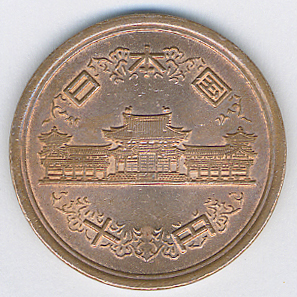
The 10 yen coin is one denomination of the Japanese yen.
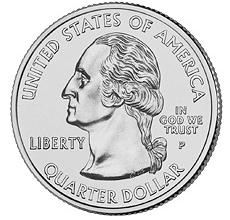
The term uncirculated coin can refer to three things:
One of the most profitable aspects of the Royal Canadian Mint (RCM) is its numismatic product line. The first numismatic coin from the RCM was arguably the 1935 dollar commemorating the Silver Jubilee of His Majesty King George V. Though intended for circulation, it was the first Canadian coin commemorating an event. The decision to issue this coin was made in October 1934 by then-Prime Minister R.B. Bennett. There were economic and patriotic motivations for the release of a silver dollar, including a hope to boost the silver mining industry. In future years, the silver dollar would have a more emotional meaning for many Canadians because it was also the first coin to have the Voyageur motif on its reverse.
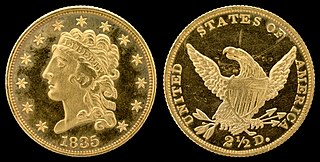
The Classic Head $2.50 gold coin is an American coin, also called a quarter eagle, minted from 1834 to 1839. It features Liberty on the obverse and an eagle on the reverse.

The 1-yen coin is the smallest denomination of the Japanese yen currency. Historically they were initially made of both silver and gold in the early 1870s. Issues facing the Japanese government at the time included wanting to adopt the gold standard, and competing against the Mexican dollar for use in foreign trade. The decision was made to use silver one yen coins exclusively outside of Japan for trade, while gold coins were minted and used in mainland Japan. Gold and silver coins were eventually allowed to co-circulate in mainland Japan from 1878 to 1897 when they were demonetized. Millions of former one yen silver coins were countermarked by the Japanese government for use outside of the mainland. Silver one yen coins continued to be minted until 1914 for backing up currency.

The Sheldon Coin Grading Scale is a 70-point coin grading scale used in the numismatic assessment of a coin's quality. The American Numismatic Association based its Official ANA Grading Standards in large part on the Sheldon scale. The scale was created by William Herbert Sheldon.
The 5,000 yen coin is a denomination of the Japanese yen used only for commemoratives struck by the Japan Mint. These are made only for collectors who purchase them directly from the mint at a premium. 5000 yen commemorative coins have historically been struck in a silver alloy since 1990. This practice changed in 2021 when gold was used for the first time for a coin celebrating 150 years of Japan's modern currency system. Measurements for the coins in terms of width and weight have remained the same except for the gold issue when these were lowered. Earlier coins were also once struck in the millions before the alloy change took place.

The double sovereign is a gold coin of the United Kingdom with a nominal value of two pounds sterling (£2). Rarely issued in the first century and a half after its debut in 1820, it never had a significant presence in circulation. It is now a collector and bullion coin, and has been struck most years since 1980. It features the reigning monarch on its obverse and, most often, Benedetto Pistrucci's depiction of Saint George and the Dragon on the reverse.

The Apollo 11 50th Anniversary commemorative coins were issued by the United States Mint in 2019 to commemorate the 50th anniversary of the first crewed landing on the Moon by Apollo 11 astronauts Neil Armstrong and Buzz Aldrin. Consisting of a gold half eagle, two different sizes of silver dollars, and a copper-nickel clad half dollar, each of the four was issued in proof condition, with all but the larger silver dollar also issued in uncirculated. The gold coins were struck at the West Point Mint, the silver at the Philadelphia Mint and the base metal half dollars at the mints in Denver and San Francisco.
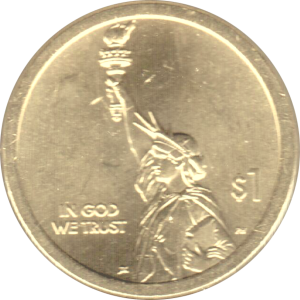
American Innovation dollars are dollar coins of a series minted by the United States Mint beginning in 2018 and scheduled to run through 2032. It is planned for each member of the series to showcase an innovation, innovator or group of innovators from a particular state or territory, while the obverse features the Statue of Liberty.
The 100,000 yen coin is a denomination of the Japanese yen. Only two different types of coins have ever been struck in this denomination, which is only used for the minting of commemorative coins struck by the Japan Mint. Proof coinage and uncirculated examples were made for collectors, none were ever intended or released for circulation.
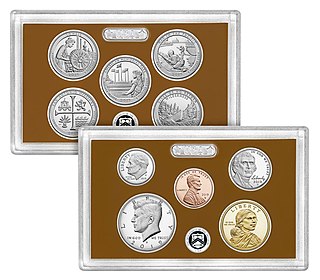
The United States Mint Proof Set, commonly known as the Proof Set in the United States, is a set of proof coins sold by the United States Mint. The proof set is popular with coin collectors as it is an affordable way to collect examples of United States coinage in proof condition.
The United States Uncirculated Coin Set, known as the Uncirculated Set or Mint Set in the United States, is an annual coin set sold by the United States Mint. The set is marketed towards coin collectors as a way to obtain circulation coins in mint condition.

The 1893-S Morgan dollar is a United States dollar coin struck in 1893 at the San Francisco Mint. It is the lowest mintage business strike Morgan dollar in the series. The 1893-S is considered to be a key date in the Morgan dollar series: examples of the coin in both mint state and in circulated condition are valuable.
















